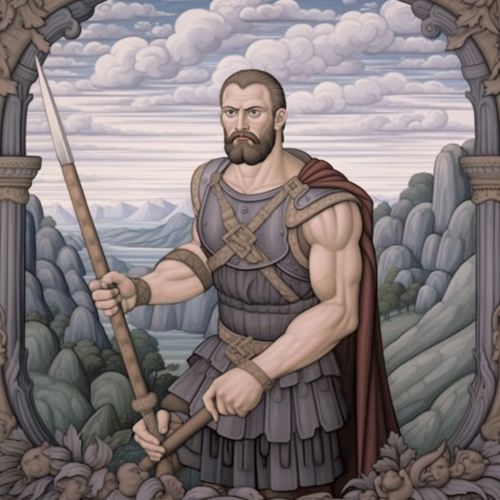Twelve Labors
Introduction
The Twelve Labors, also known as the Dodekathlon, are a series of episodes concerning a penance carried out by Heracles, also known as Hercules in Roman mythology. These labors were assigned to Heracles by King Eurystheus as part of his sentence after he killed his wife and children in a fit of madness, induced by the goddess Hera. The labors were seemingly insurmountable tasks intended to cause Heracles' death, yet he accomplished all of them, securing his immortality in the annals of myth and legend.


The Labors
The Nemean Lion
The first of the Twelve Labors involved the slaying of the Nemean Lion, a monstrous beast that was terrorizing the region of Nemea. The lion was impervious to mortal weapons due to its golden fur, which was akin to armor. Heracles strangled the lion to death and subsequently used its own claw to skin it, wearing its hide as a protective cloak for the remainder of his labors.
The Lernaean Hydra
The second labor was to slay the Lernaean Hydra, a multi-headed serpent-like creature that dwelled in the swamp of Lerna. Each time one of the Hydra's heads was cut off, two more would grow in its place. With the help of his nephew Iolaus, Heracles cauterized the neck stumps after decapitation, preventing the growth of new heads, and buried the immortal head under a large rock.
The Golden Hind of Artemis
For his third labor, Heracles was tasked with capturing the Golden Hind of Artemis, a deer with golden antlers and bronze hooves. This task was particularly challenging as the Hind was sacred to Artemis, the goddess of the hunt, and Heracles had to capture it without causing any harm. After a year-long chase, Heracles managed to capture the Hind while it was sleeping and returned it to Eurystheus.
The Erymanthian Boar
The fourth labor involved capturing the Erymanthian Boar, a gigantic and ferocious creature that was causing havoc on Mount Erymanthus. Heracles chased the boar through thick snow and, after exhausting it, trapped it in a net and brought it back to Eurystheus.
The Augean Stables
The fifth labor, cleaning the Augean Stables, was intended to be both humiliating and impossible, as the stables, which housed the single greatest number of cattle in the country, had not been cleaned in over 30 years. However, Heracles accomplished this task by rerouting the rivers Alpheus and Peneus to wash out the filth.
The Stymphalian Birds
The sixth labor was to drive away the Stymphalian Birds, man-eating birds with beaks of bronze and sharp metallic feathers they could launch at their victims. Heracles scared the birds from their nests with a rattle given to him by Athena and shot them down with his bow and arrows as they flew away.
The Cretan Bull
For his seventh labor, Heracles had to capture the Cretan Bull, a beautiful but destructive bull sent by Poseidon to ravage the lands of King Minos of Crete. Heracles wrestled the bull into submission and shipped it back to Eurystheus.
The Mares of Diomedes
The eighth labor involved capturing the Mares of Diomedes, four man-eating horses owned by the giant Diomedes. Heracles killed Diomedes and fed him to his own horses, which pacified them and allowed Heracles to bind their mouths shut.
The Belt of Hippolyta
The ninth labor was to obtain the girdle of Hippolyta, the Queen of the Amazons. Initially, Hippolyta was so impressed with Heracles that she agreed to give him the girdle freely. However, Hera intervened, causing the Amazons to attack Heracles in the belief that he was kidnapping their queen. In the ensuing battle, Heracles killed Hippolyta, took the girdle, and returned to Eurystheus.
The Cattle of Geryon
The tenth labor was to steal the cattle of the monster Geryon, who lived on the island of Erytheia in the far west. Geryon had three bodies and three heads, and his cattle were guarded by the two-headed dog Orthrus. Heracles killed Orthrus, Geryon, and the herdsman Eurytion, and drove the cattle back to Eurystheus.
The Apples of the Hesperides
For his eleventh labor, Heracles was to steal the golden apples from the garden of the Hesperides, which were guarded by the hundred-headed dragon Ladon. After several adventures, including wrestling the titan Atlas, Heracles managed to obtain the apples and return them to Eurystheus.
The Capture of Cerberus
The final and most dangerous labor was to capture Cerberus, the three-headed dog that guarded the entrance to the Underworld. Heracles was able to tame Cerberus with the help of Hermes and Athena, and brought the beast back to Eurystheus, who was so terrified that he released Heracles from his service.
Conclusion
The Twelve Labors of Heracles are among the most famous adventures in Greek mythology. They represent the hero's struggle against impossible odds, his resourcefulness, and his endurance. The labors also served as a means for Heracles to atone for his past sins and achieve immortality, becoming a symbol of strength and perseverance for generations to come.
